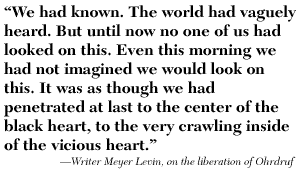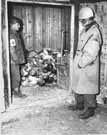
|
|
|

|

|

|

|
|
Click on an image to see a larger, more detailed picture.
|
|
|
|
|
| 1945: Liberation and Rebuilding |

|
pg. 591 |

|
|
|
|
| |

|
 The SS shot these Polish inmates in a mass execution at Ohrdruf, Germany. As so often happened, the Germans killed their prisoners rather than see them fall into the hands of the Allies. American General Omar Bradley said of the atrocities at Ohrdruf: "The smell of death overwhelmed us even before we passed through the stockade. More than 3200 naked, emaciated bodies had been flung into shallow graves. Others lay in the streets where they had fallen. Lice crawled over the yellowed skin of their sharp, bony frames."
The SS shot these Polish inmates in a mass execution at Ohrdruf, Germany. As so often happened, the Germans killed their prisoners rather than see them fall into the hands of the Allies. American General Omar Bradley said of the atrocities at Ohrdruf: "The smell of death overwhelmed us even before we passed through the stockade. More than 3200 naked, emaciated bodies had been flung into shallow graves. Others lay in the streets where they had fallen. Lice crawled over the yellowed skin of their sharp, bony frames."
Photo: Nancy & Michael Krzyzanowski/United States Holocaust Memorial Museum Photo Archive
|
 Liberation of Ohrdruf
Liberation of Ohrdruf
The labor camp Ohrdruf, near Gotha, Germany, occupies a distinct place in history. The first camp liberated by the Western Allies, Ohrdruf provided American troops with proof of Nazi barbarity. At Ohrdruf, thousands of slave laborers had worked frantically under brutal conditions to prepare an underground communications center for the German Army. On April 4, 1945, American soldiers entering Ohrdruf (pictured) found mass graves containing thousands of corpses. Some prisoners had been executed and hastily buried only four days before the Americans entered the camp. The troops also encountered a few living witnesses, men who had escaped from the camp shortly before the Nazis began shooting the remaining prisoners. Eight days after the camp was liberated, U.S. Generals Dwight Eisenhower, Omar Bradley, and George Patton, men deeply familiar with the mayhem of war, visited the camp. An angered Eisenhower encouraged the press to tour the camp and inform the world of the atrocities committed there.
Photo: Wide World Photo / United States Holocaust Memorial Museum Photo Archive
|
|

|

|

|

|
 January 25, 1945: The SS evacuates the concentration camp at Stutthof, Poland.
January 25, 1945: The SS evacuates the concentration camp at Stutthof, Poland.
|
 January 26, 1945: One thousand Jewish women interned at the Neusalz, Poland, slave-labor camp are set on a month-and-a-half-long forced march to the concentration camp at Flossenbürg, Germany, about 200 miles to the southwest. Along the way, 800 are beaten and shot; See February 15, 1945.
January 26, 1945: One thousand Jewish women interned at the Neusalz, Poland, slave-labor camp are set on a month-and-a-half-long forced march to the concentration camp at Flossenbürg, Germany, about 200 miles to the southwest. Along the way, 800 are beaten and shot; See February 15, 1945.
|
 January 27, 1945: Soviet troops liberate Auschwitz and find 7000 living inmates, including Anne Frank's father, Otto. They also discover more than 830,000 women's coats and dresses, nearly 348,000 men's suits, and seven tons of human hair.
January 27, 1945: Soviet troops liberate Auschwitz and find 7000 living inmates, including Anne Frank's father, Otto. They also discover more than 830,000 women's coats and dresses, nearly 348,000 men's suits, and seven tons of human hair.
|
 January 27, 1945: Memel, Lithuania, is liberated by Soviet troops.
January 27, 1945: Memel, Lithuania, is liberated by Soviet troops.
|
 Late January 1945: A forced march of several thousand Jews is undertaken from the Danzig/Königsberg region of Germany to the coastal city of Palmnicken. At least 700 marchers are shot along the way and, with the exception of a few who escape, the remainder are machine-gunned by the SS at the edge of the Baltic Sea.
Late January 1945: A forced march of several thousand Jews is undertaken from the Danzig/Königsberg region of Germany to the coastal city of Palmnicken. At least 700 marchers are shot along the way and, with the exception of a few who escape, the remainder are machine-gunned by the SS at the edge of the Baltic Sea.
|
|
|
|
|
| 1945: Liberation and Rebuilding |

|
pg. 591 |

|
|
The Holocaust Chronicle
© 2009 Publications International, Ltd.
|
|
